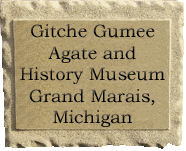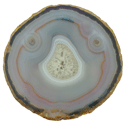MINERAL OF THE MONTH
December 2007: Nepheline Syenite
In keeping with the latest web page effort to provide information about the Lake Superior basin, this month’s Mineral of the Month is Nepheline Syenite.
Nephelene syenite is an igneous rock that consists largely of nepheline and alkali feldspar. The rocks are mostly pale colored, grey or pink, and in general appearance they are not unlike granites, but dark green varieties are also known.
Nepheline syenites typically are formed by low degrees of partial melting in the Earth's mantle, very often in plate tectonic subduction zones. It also forms in the magma chambers of volcanos, such as that which is found on the eastern shore of Lake Superior in the Coldwell Alkaline Complex. This geologic structure consists of a curcular plug of rock, much different than any other rock in the area. It is over 15 miles in diameter, stretching from the Little Pic River to the town of Marathon.
Syenite is a rare rock in the Earth’s crust. Nepheline syenite is even less common. It has a hardness of 6, specific gravity of 2.57, and weighs 160 pounds per cubic foot. Depending on where this rock forms, it can contain up to 12 elements. The Nepheline Syenite found in Ontario formed in the middle Proterozoic age, just over 1.1 million years ago.
Nepheline syenite has become preferred to feldspar as a source of alumina and alkalis for glass manufacture. It promotes more rapid melting at lower temperatures, thus reducing energy consumption, lengthening the life of the furnace, and improving the yield and quality of the glass that is manufactured. The material is also used in ceramic glazes and enamels and in fillers in paints, papers, plastics, and foam ruber. Its solid nature enables it to be used in the building industry to make huricane and fire-proof buildings, roofing material, and decorative stone. It is also used to make self-sealing glass containers to transport nuclear waste products. Canada was the first country (1932) to develop the use of nepheline syenite as a raw material for glass, ceramic, and filler industries.
Mineral of the Month Archives
May 2007 Mineral of the Month
June 2007 Mineral of the Month
July 2007 Mineral of the Month
August 2007 Mineral of the Month
Fall 2007 Mineral of the Month
December 2007 Mineral of the Month
January 2008 Mineral of the Month
February 2008 Mineral of the Month
March 2008 Mineral of the Month
April 2008 Mineral of the Month
May 2008 Mineral of the Month
June 2008 Mineral of the Month
Copyright All rights reserved.
Gitche Gumee Museum.
E21739 Brazel Street
Grand Marais, Michigan 49839







